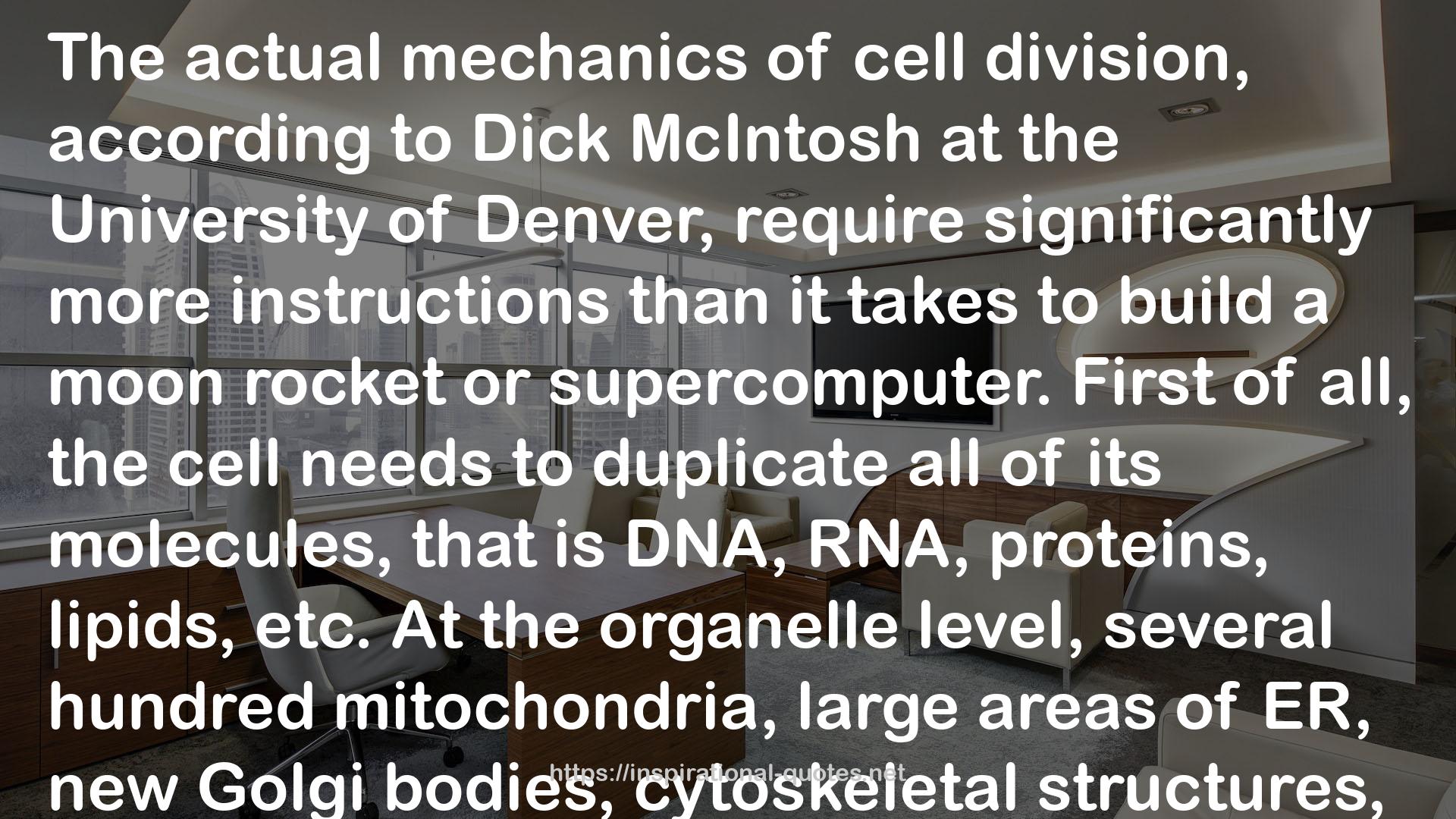" The actual mechanics of cell division, according to Dick McIntosh at the University of Denver, require significantly more instructions than it takes to build a moon rocket or supercomputer. First of all, the cell needs to duplicate all of its molecules, that is DNA, RNA, proteins, lipids, etc. At the organelle level, several hundred mitochondria, large areas of ER, new Golgi bodies, cytoskeletal structures, and ribosomes by the million all need to be duplicated so that the daughter cells have enough resources to grow and, in turn, divide themselves. All these processes make up the ‘cell cycle’. Some cells will divide on a daily basis, others live for decades without dividing. The cell cycle is divided into phases, starting with interphase, the period between cell divisions (about 23 hours), and mitosis (M phase), the actual process of separating the original into two daughter cells (about 1 hour). Interphase is further split into three distinct periods: gap 1 (G1, 4–6 hours), a synthesis phase (S, 12 hours), and gap 2 (G2, 4–6 hours). Generally, cells continue to grow throughout interphase, but DNA replication is restricted to the S phase. At the end of G1 there is a checkpoint. If nutrient and energy levels are insufficient for DNA synthesis, the cell is diverted into a phase called G0. In 2001 Tim Hunt, Paul Nurse, and Leeland Hartwell received the Nobel Prize for their work in discovering how the cell cycle is controlled. Tim Hunt found a set of proteins called cyclins, which accumulate during specific stages of the cell cycle. Once the right level is reached, the cell is ‘allowed’ to progress to the next stage and the cyclins are destroyed. Cyclins then start to build up again, keeping a score of the progress at each point of the cycle, and only allowing progression to the next stage if the correct cyclin level has been reached. "
― , The Cell: A Very Short Introduction
Image for Quotes

Tim Hunt,
Paul Nurse, and Leeland Hartwell received the Nobel Prize for their work in discovering how the cell cycle is controlled. Tim Hunt found a set of proteins called cyclins, which accumulate during specific stages of the cell cycle. Once the right level is reached, the cell is ‘allowed’ to progress to the next stage and the cyclins are destroyed. Cyclins then start to build up again, keeping a score of the progress at each point of the cycle, and only allowing progression to the next stage if the correct cyclin level has been reached." style="width:100%;margin:20px 0;"/>
 Tim Hunt, Paul Nurse, and Leeland Hartwell received the Nobel Prize for their work in discovering how the cell cycle is controlled. Tim Hunt found a set of proteins called cyclins, which accumulate during specific stages of the cell cycle. Once the right level is reached, the cell is ‘allowed’ to progress to the next stage and the cyclins are destroyed. Cyclins then start to build up again, keeping a score of the progress at each point of the cycle, and only allowing progression to the next stage if the correct cyclin level has been reached." style="width:100%;margin:20px 0;"/>
Tim Hunt, Paul Nurse, and Leeland Hartwell received the Nobel Prize for their work in discovering how the cell cycle is controlled. Tim Hunt found a set of proteins called cyclins, which accumulate during specific stages of the cell cycle. Once the right level is reached, the cell is ‘allowed’ to progress to the next stage and the cyclins are destroyed. Cyclins then start to build up again, keeping a score of the progress at each point of the cycle, and only allowing progression to the next stage if the correct cyclin level has been reached." style="width:100%;margin:20px 0;"/>